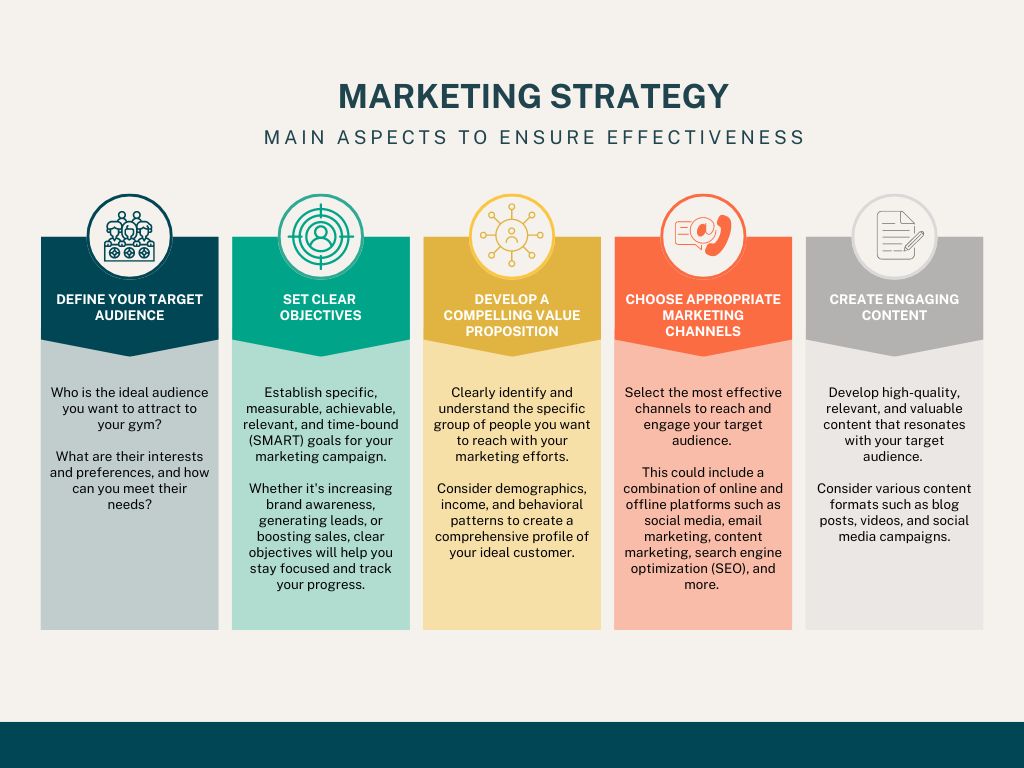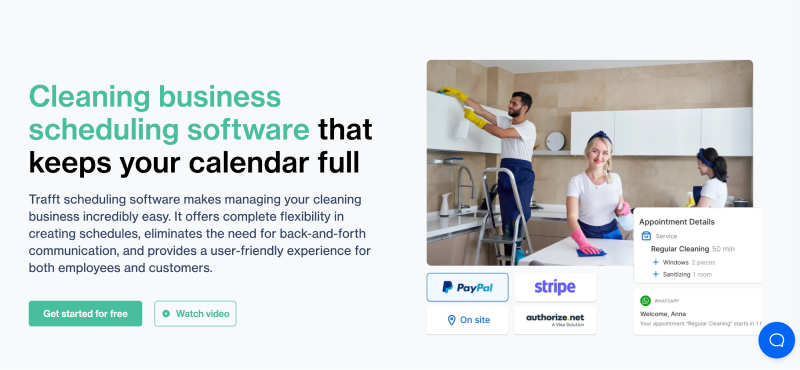Are you an aspiring gym business owner looking to make this exciting endeavor as smooth as possible? Whether you are just starting out or are knee-deep into the whole process, there are ways to ensure this venture doesn’t turn sour. Crafting a comprehensive gym business plan is your ticket to success.
However, this is often easier said than done. So, to help you navigate this crucial aspect of running your own business, we put together an ultimate guide.
We will cover everything from the basics of a business plan to the necessary steps for creating your own. Read on and let’s turn your gym business dream into reality!
What Is a Gym Business Plan?
A gym business plan is a document that outlines the gym's mission, vision, objectives, strategies, and financial projections. Essentially, it serves as a blueprint that guides your decisions and actions when starting and running your gym.
Did you know that 81% of fitness studios fail within their first year? Given this high number, knowing how to make a gym business plan that works has become more important than ever.
Creating a well-thought-out business plan doesn’t only serve you but your potential investors as well. Starting a gym can be a price venture, and doing it on your own is often not an option. You need to think about securing the financing needed to start, but in order to do so, you need to show investors that you have a clear picture of the whole process.
A comprehensive fitness gym business plan demonstrates that you have thoroughly researched the market, understood your target audience, and have a strategy in mind for conquering the competitive landscape.
In continuation, we will cover each component of a business plan, breaking down the process into steps so that you can easily craft yours by the end.
What Every Gym Business Plan Should Include
Having a business plan may now seem like a necessary step if you want your gym to succeed. But that still doesn’t tell you how to write a gym business plan from scratch. The important thing to remember is that business plans can vary just as much as businesses do. This can make it hard to be sure you are creating something that actually makes sense.
Fortunately, the whole process is not as arbitrary as you may think. There is a simple gym business plan template you can follow when creating your own unique blueprint. To make it easy, we’ll break each component into a manageable section.
1. Executive summary
The executive summary is an introduction to your business plan that should provide an overview of all the key points. Even though it's the first section it's often written last so nothing's left out.
It should clearly outline your business's purpose and goals, what you aim to achieve, and how you plan to address the objectives. Make sure it's attention-grabbing so potential investors keep reading your plan and not discard your whole idea. Also, don't make it too long; think of it as a sort of elevator pitch for your business, it should be captivating and clear.
Aim to answer the following questions:
- Who are you?
- What are you offering?
- What is your mission?
- How are you going to accomplish it?
- What’s your vision?
2. Company description
Company description defines your gym’s identity and purpose. It should also cover what you intend to achieve in the long run.
What are your gym's core values? Are you aiming for excellence or inclusivity? These values define your gym’s culture and shape how you interact with your clients and employees. They help you stay consistent and make your gym stand out.
Remember to include your foundation story. People love hearing background stories about their favorite businesses, and they make you, as an owner, more human. Investors want to know where you are coming from and what you aspire your business to be. Look at it this way: the more they know, the more likely they are to trust you.
Include the legal structure of your business. Whether it's a sole proprietorship, limited liability company, or corporation, this will give you and your investors an idea of your gym's power structure.
Lastly, include some Unique Selling Points. USPs should cover what sets you apart from the competition. Not every gym is the same, so be sure you clearly state what makes yours so different. Do your research and see what’s missing in the market. Are there any gaps you can fill? Be sure to give investors a reason to choose your gym business over someone else’s.
3. Market analysis
A gym's business plan must include a comprehensive analysis of the current market. Market analysis aims to understand the dynamics, trends, and opportunities in the fitness industry.
In this step, you will define your niche, determine the overall market size, and identify your ideal customers.

4. Competitor analysis
Competitor analysis refers to evaluating your rivals' strengths, weaknesses, and strategies. When looking at the fitness industry as a whole, it’s practically impossible not to see what’s already out there, which is a great thing. Examining others can give you an opportunity to differentiate your gym and gain a unique position in the market.
Begin by identifying main competitors in your local area and later on expand to indirect competitors. This way you will also gain insight into what can be sold or additionally offered in your gym.
When checking out your competition, don’t forget to look into their strategies. If a fitness center is popular, that is likely for a good reason. See if you can implement something in your gym business plan.
Lastly, carefully evaluate weaknesses so you know what areas they fall short in meeting customers' needs.
5. Services and products
Services and products are pivotal points of any successful gym business. They attract new customers and retain existing members.
In this section of a gym business plan, outline all that you offer, but highlight what makes your gym unique.
Is there something you offer that people can’t get someplace else?
Perfect, make it a focal point of this section so it’s obvious what sets your gym apart. This includes unique features, special programs, or amenities that meet the diverse needs of your target audience.
Go into as much detail as possible, mention different membership plans, necessary equipment, facilities and fitness classes. Having everything on paper will also help you avoid making unnecessary purchases down the road.
6. Organization and management
The organization and management part of a gym business plan should cover the organizational structure and the management team that will oversee everything.
Who are the owners? And what percentage do they have? Are you planning on running a sole proprietorship, partnership, corporation, or limited liability company?
All of these should be defined in this part of the business plan so it’s clear who makes the decisions.

Image by rawpixel.com on Freepik
Additionally, outline the key employees in your gym’s management team and your staffing plans for the future. Include the number of front desk managers, personal trainers, maintenance staff, administrative staff, etc.
How do you plan on executing training and development for your employees? And what are some HR policies and procedures you plan on implementing?
While this may seem a bit excessive, especially if you are just starting out, having a mindset of “I’ll just wing it” or “That all will easily fall into place once a gym starts running” can scare potential investors away and cost you your gym’s success.
Don’t get us wrong; it’s not like there is no flexibility whatsoever. We are not saying a gym business plan is set in stone; rather, it’s there to help you stay on the right path.
7. Marketing
It’s surely not surprising that the fitness industry is extremely competitive, so how can you ensure your gym stands out from the crowd?
Marketing is essential for attracting new members, building brand awareness, and driving business growth. In this section of a business plan for a gym, outline strategies and tactics you plan on using in order to promote your business, engage with the perfect audience, and differentiate your gym from the others.
You should clearly emphasize your brand identity, values, and personality in this segment. Also, include a plan for establishing your online presence through a professional website and social media platforms. Cover all the marketing channels you plan on utilizing and the promotional campaigns you plan on carrying out. When deciding on appropriate marketing efforts, always consider your target audience and what’s the best way to reach them.

Marketing can be expensive, so be sure you allocate an appropriate budget. However, don’t go overboard. You don’t have to make use of all channels. Once you are sure who you want to target, your business plan should outline all the ways to get to them.
When it comes to advertising, hitting all the boxes can be tricky, but it’s important to do so, as it can either make or break your business. To help you make a proper plan and execute it correctly, we put together this guide on gym marketing ideas and strategies that work.
8. Sales strategy
Sales strategy refers to a part of a gym business plan that outlines tactics and techniques you'll use to drive sales, maximize revenue, and increase customer retention. This essentially includes all strategies for converting prospects into loyal customers.
As you can probably guess, sales strategies are closely related to marketing efforts, and developing one can’t be successful without considering the other.
Make sure you answer these questions in this part of the plan:
- What are your sales goals and objectives?
- How will you communicate pricing and membership options?
- What's a follow-up strategy for prospects not yet ready for purchase?
- How will you train and develop your sales team?
- What lead-generating strategies do you plan on using to gain new members?
9. Operations plan
Behind the scenes of every successful gym is a well-organized and efficient operations plan. This plan ensures smooth day-to-day functioning and exceptional customer experience.
When creating your gym business plan, outline the logistical and operational details that cover how your gym will run on a daily basis. From facility management to staff scheduling, this section provides insight into the operational framework that supports the overall success of your gym.
In this segment, you should also include inventory management and specify how the supplies and equipment will be ordered and stored. Next, cover customer service so both you and your potential investors can see how important client satisfaction is and how it will be handled.
For many, this is one of the most important parts of running a business, and it can become pretty overwhelming. But there are ways to make it more manageable.
How can fitness scheduling software help you run a successful business?

Handling all day-to-day operations by yourself can be a huge burden on your time. But leaving it all to software can be a bit scary. After all, not every booking solution is cut for this job. Meet Trafft, a fitness scheduling software designed specifically with the unique needs of fitness business owners in mind.
With Trafft, your members can easily book their workouts, group classes, and personal training sessions online, giving them the flexibility they desire and freeing up your staff's time to focus on delivering exceptional service.
But that's far from all that Trafft can do for you. In addition to maximizing your facility's usage, avoiding double booking, and optimizing class capacities, Trafft's appointment reminders and follow-up messages can enhance communication with your members and keep them engaged in their fitness journey.
And that's just the tip of the iceberg. If you are interested in your gym's performance, including attendance trends, revenue tracking, and member satisfaction, there is no better tool than Trafft.
Sounds interesting? Check out all the fitness scheduling software and see why so many successful gyms are already using it.
10. Funding request
Opening a gym business is a pricey endeavor, so you will likely need some financing help along the way. But how do you include this in your business plan and secure what you need?
Whether you're seeking investment from other individuals, loans from financial institutions, or contributions from private investors, the Funding Request section of your business plan should clearly outline your needs. But don't just put a number and call it a day. You need to explain how you plan on using the funds to launch and grow your business.
Be sure to cover the following expense categories:
- Purchasing or renting a facility
- Equipment costs
- Marketing and advertising
- Working capital
11. Financial projections
Finally, your gym business plan should include financial projections for the future. In this section, you should have a detailed forecast of your gym's financial performance over a specified period, typically five to several years.
By presenting realistic and data-driven projections, you demonstrate your gym business's revenue-generating potential and profitability. This instills confidence in stakeholders and helps you secure the necessary funding for your venture.
How to Create a Successful Gym Business Plan
Creating a business plan can be an overwhelming task, but once it is broken down into steps, it becomes much more manageable. But how can you ensure that the plan you create will yield good results?
Well, besides closely following the structure we mentioned, there are some additional tips that can help you further.
Collect data
When creating a business plan, the more data you have, the better you can make your plan. Research and data collection will ensure you make informed decisions every step of the way.
Start by diving deeper into your target audience. See how old they are, what their workout habits are, and what they want to achieve. Then, move on to researching your competitors. What are they doing right, and how can you fill any gaps they have left? What are their marketing tactics and pricing strategies? This all will come in handy when crafting your perfect plan.
Lastly, don’t overlook collecting data about your business. Once your gym is up and running, see how satisfied your clients are, how good membership sells, and how well your employees perform. Trafft's business dashboard helps you analyze occupancy, employee performance and much more with just one glance!
Set the right goals
People often get carried away when defining what they want to achieve. While being ambitious is always a good thing, having too many goals can lead to achieving none of them. When defining where you want your business to be in a few months or years, try utilizing SMART criteria.
The acronym SMART stands for goals that are specific, measurable, achievable, realistic, and time-bound. Clarity and precision in goal-setting will help you see what you have achieved and what you need to work on further.
Focus on details
Focusing on details will guarantee that every aspect of your gym business plan is thoroughly considered and carefully planned out. Delving into the specifics will give you deeper insights into the opportunities and challenges facing your gym business. On the other hand, no investor wants to read a business plan that is feeble and covers only the basics.
Maintaining clarity and going into as much detail as possible lays a solid foundation for successfully implementing your business plan.
Update your business plan
We already mentioned that the gym business plan is a blueprint for how you plan to run your business. The fitness industry is always changing, so to ensure you are evolving with it, review your business plan regularly and change what is no longer relevant.
Keeping your business plan up-to-date demonstrates your commitment to staying agile and adaptive in a dynamic landscape, positioning your gym for sustained growth and success.
Speak to a professional
Seeking advice from a professional can provide invaluable insights and expertise needed to make your business plan a success. Whether it's a business consultant, fitness industry expert, or financial advisor, consulting with professionals can provide guidance where necessary.
By leveraging their expertise, you can strengthen your business plan, lower risks, and maximize opportunities for success. Remember, investing in professional advice is investing in your gym's future growth.

Conclusion
Understanding how to make a business plan for a fitness center is crucial for aspiring gym owners looking to navigate the complexities of this industry successfully.
By following the step-by-step guidance provided here, you can craft a comprehensive business plan that not only outlines your gym's mission, vision, and objectives but also serves as a strategic roadmap for achieving your goals.
From conducting thorough market and competitor analysis to defining your gym's unique selling points and sales strategies, each component of your business plan is instrumental in shaping the future of your gym business.
By meticulously detailing your plans, setting SMART goals, and seeking professional advice when needed, you can enhance the likelihood of securing funding and ultimately building a thriving gym business.
Take the time to develop a business plan that reflects your passion for fitness, addresses the needs of your target market, and positions your gym for long-term success. And if you need any help along the way, discover how to grow a gym with Trafft.






